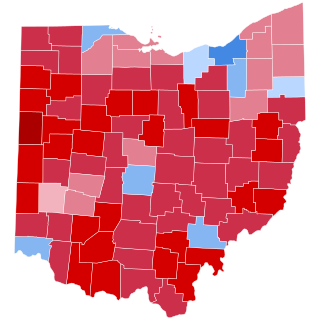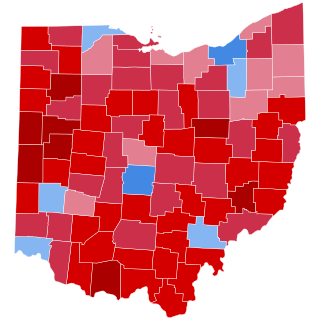
In American politics, the term swing state refers to any state that could reasonably be won by either the Democratic or Republican candidate in a statewide election, most often referring to presidential elections, by a swing in votes. These states are usually targeted by both major-party campaigns, especially in competitive elections. Meanwhile, the states that regularly lean to a single party are known as safe states, as it is generally assumed that one candidate has a base of support from which they can draw a sufficient share of the electorate without significant investment or effort by their campaign.

The 2006 Ohio gubernatorial election was held on November 7, 2006, and was a race for the Governor and Lieutenant Governor of Ohio. Incumbent Governor Bob Taft could not run for re-election, because Ohio governors are limited to two consecutive terms in office. The election was held concurrently with a U.S. Senate election. The general election for governor pitted Ohio Secretary of State Ken Blackwell, the Republican nominee, against United States Congressman Ted Strickland of Ohio's 6th congressional district, the Democratic nominee. Their running mates were former Ohio Attorney General Lee Fisher on the Democratic ticket and State Representative Tom Raga on the Republican ticket.
Political control of Ohio has oscillated between the two major parties. Republicans outnumber Democrats in Ohio government. The governor, Mike DeWine, is a Republican, as are all other non-judicial statewide elected officials: Lieutenant Governor of Ohio Jon A. Husted, Ohio Attorney General Dave Yost, Ohio State Auditor Keith Faber, Ohio Secretary of State Frank LaRose and Ohio State Treasurer Robert Sprague.

The Missouri bellwether was a political phenomenon that noted that the state of Missouri voted for the winner in all but one U.S. presidential election from 1904 to 2004. While states like Pennsylvania, Nevada, Florida and Wisconsin have been arguably stronger indicators of political trends in recent years, Missouri was a consistent swing state throughout the 20th century. Prior to the 2008 elections, Lincoln County, Missouri was said to be the only bellwether county in a bellwether state. Missouri was also considered a bellwether of U.S. views on hot-button social issues such as stem cell research and school vouchers. Some economists also considered the state a bellwether for economic trends such as consumer confidence and unemployment.

The 2008 United States presidential election in Ohio took place on November 4, 2008, which was part of the 2008 United States presidential election. Voters chose 20 representatives, or electors to the Electoral College, who voted for president and vice president.
"As Maine goes, so goes the nation" was once a maxim in United States politics. The phrase described Maine's reputation as a bellwether state for presidential elections. Maine's September election of a governor predicted the party outcome of the November presidential election in 22 out of the 29 presidential election years from 1820 to 1932: namely 1820–1844, 1852, 1860–1880, 1888, 1896–1908 and 1920–1932; more importantly, as Maine was a generally Republican-leaning state, the margin of the September elections compared to expectations could predict national November results more than the identity of the winning party in Maine. A contest still won by the Republicans but with a narrower margin than usual would still predict good Democratic results nationally.

The 2012 United States presidential election in Ohio took place on November 6, 2012, as part of the 2012 United States presidential election in which all 50 states plus the District of Columbia participated. Ohio voters chose 18 electors to represent them in the Electoral College via a popular vote pitting incumbent Democratic President Barack Obama and his running mate, Vice President Joe Biden, against Republican challenger and former Massachusetts Governor Mitt Romney and his running mate, Congressman Paul Ryan. This election continued Ohio's bellwether streak, as the state voted for the winner of the presidency in every election from 1964 to 2016.

The 1968 United States presidential election in Ohio took place on November 5, 1968. All 50 states and The District of Columbia were part of the 1968 United States presidential election. Ohio voters chose 26 electors to the Electoral College, who voted for president and vice president.

The 2016 United States presidential election in North Carolina held on Tuesday, November 8, 2016, as part of the 2016 United States presidential election in which all 50 states plus the District of Columbia participated. North Carolina voters chose electors to represent them in the Electoral College via a popular vote, pitting the Republican Party's nominee, businessman Donald Trump, and running mate Indiana Governor Mike Pence against Democratic Party nominee, former Secretary of State Hillary Clinton, and her running mate Virginia Senator Tim Kaine. North Carolina has 15 electoral votes in the Electoral College.

The 2016 United States presidential election in Oklahoma was held on Tuesday, November 8, 2016, as part of the 2016 United States presidential election in which all 50 states plus the District of Columbia participated. Oklahoma voters chose electors to represent them in the Electoral College via a popular vote, pitting the Republican Party's nominee, businessman Donald Trump, and running mate Indiana Governor Mike Pence against Democratic Party nominee, former Secretary of State Hillary Clinton, and her running mate Virginia Senator Tim Kaine. Oklahoma has seven electoral votes in the Electoral College.

The 2016 United States presidential election in Virginia was held on November 8, 2016, as part of the 2016 general election in which all 50 states plus the District of Columbia participated. Virginia voters chose electors to represent them in the Electoral College via a popular vote pitting the Republican Party's nominee, businessman Donald Trump, and running mate Indiana Governor Mike Pence against Democratic Party nominee, former Secretary of State Hillary Clinton and her running mate, Virginia Senator Tim Kaine.

The 2016 United States presidential election in Arizona was held on Tuesday, November 8, 2016, as part of the 2016 United States presidential elections in which all 50 states plus the District of Columbia participated. Arizona voters chose electors to represent them in the Electoral College via a popular vote, pitting the Republican Party's nominee, businessman Donald Trump, and running mate Indiana Governor Mike Pence against Democratic Party nominee, former Secretary of State Hillary Clinton, and her running mate Virginia Senator Tim Kaine. Arizona has 11 electoral votes in the Electoral College.

The 2016 United States presidential election in Ohio was held on Tuesday, November 8, 2016, as part of the 2016 United States presidential election in which all 50 states plus the District of Columbia participated. Ohio voters chose electors to represent them in the Electoral College via a popular vote, pitting the Republican Party's nominee, businessman Donald Trump, and running mate Indiana Governor Mike Pence against Democratic Party nominee, former Secretary of State Hillary Clinton, and her running mate Virginia Senator Tim Kaine. Ohio had 18 electoral votes in the Electoral College.

The 2016 United States presidential election in Indiana was held on Tuesday, November 8, 2016, as part of the 2016 United States presidential election in which all 50 states plus the District of Columbia participated. Indiana voters chose electors to represent them in the Electoral College via a popular vote, pitting the Republican Party's nominee, businessman Donald Trump, and running mate Indiana Governor Mike Pence against Democratic Party nominee, former Secretary of State Hillary Clinton, and her running mate Virginia Senator Tim Kaine. Indiana has 11 electoral votes in the Electoral College.

The 1968 United States presidential election in Texas was held on November 5, 1968. All 50 states and the District of Columbia, were part of the 1968 United States presidential election. The state chose 25 electors to represent them in the Electoral College, who voted for president and vice president.

The 1912 United States presidential election in Ohio took place on November 5, 1912 as part of the 1912 United States presidential election. State voters chose 24 electors to the Electoral College, which selected the president and vice president.

The 2020 United States presidential election in Indiana was held on Tuesday, November 3, 2020, as part of the 2020 United States presidential election in which all 50 states plus the District of Columbia participated. Indiana voters chose electors to represent them in the Electoral College via a popular vote, pitting the Republican Party's nominee, incumbent President Donald Trump, and running mate Vice President Mike Pence against Democratic Party nominee, former Vice President Joe Biden, and his running mate California Senator Kamala Harris. Indiana has 11 electoral votes in the Electoral College.

The 2020 United States presidential election in Ohio was held on Tuesday, November 3, 2020, as part of the 2020 United States presidential election in which all 50 states plus the District of Columbia participated. Ohio voters chose electors to represent them in the Electoral College via a popular vote, pitting the Republican Party's nominee—incumbent President Donald Trump and his running mate, Vice President Mike Pence—against the Democratic Party nominee, former Vice President Joe Biden and his running mate, California Senator Kamala Harris. Ohio had 18 electoral votes in the Electoral College.

The 2020 United States presidential election in Missouri was held on Tuesday, November 3, 2020, as part of the 2020 United States presidential election in which all 50 states plus the District of Columbia participated. Missouri voters chose electors to represent them in the Electoral College via a popular vote, pitting the Republican Party's nominee, incumbent President Donald Trump of Florida, and running mate Vice President Mike Pence of Indiana against Democratic Party nominee, former Vice President Joe Biden of Delaware, and his running mate Senator Kamala Harris of California. Missouri has 10 electoral votes in the Electoral College.

Elections in the U.S. state of Kentucky are held regularly. Politics in Kentucky has historically been very competitive. The state leaned toward the Democratic Party during the 1860s after the Whig Party dissolved. During the Civil War, the southeastern part of the state aligned with the Union and tended to support Republican candidates thereafter, while the central and western portions remained heavily Democratic even into the following decades. Kentucky would be part of the Democratic Solid South until the mid-20th century.


















